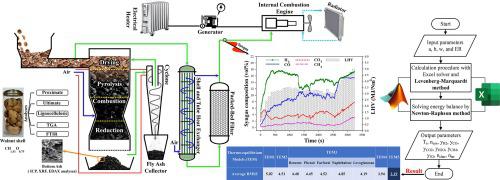Energy Conversion and Management ( IF 9.9 ) Pub Date : 2021-01-28 , DOI: 10.1016/j.enconman.2021.113836 Shahin Mazhkoo , Hossein Dadfar , MohammadSina HajiHashemi , Omid Pourali

|
In the present study, a small-scale downdraft gasification system integrated with an internal combustion engine was investigated for the sustainable conversion of biomass into energy in the form of electricity within heat recovery stages using walnut shell with a lower heating value of 18.07 . Different measurements and analyses, including biomass characteristics, syngas composition, bottom ash assessment, and flue gas emission, were performed to monitor and evaluate the quality of feedstock and products. The results indicated that with increasing electrical loads from 4 to 12 kW, the lower heating value of syngas decreased from 5.07 to 4.72 , while the cold gas efficiency and carbon conversion efficiency increased from 66% to 71%, and 74% to 83%, respectively. The syngas composition was found to be 15.42–14.78 % , 17.31–16.87% , 6.93–7.29% , 3.41–2.77% , and 56.93–58.29% . From the bottom ash analyses results, it was observed that walnut shell biochar contained high concentrations of and that could have many effects on the gasification process, such as tar removal, reduction, and less agglomeration. In addition, a modified quasi-thermo-equilibrium model has been proposed to predict the composition of syngas, yields of tar (five common biomass tar compounds), and char released during the gasification process. To improve the accuracy of the model, non-equilibrium correction factors were estimated and validated with 40 experimental data sets, including 25 various biomass feedstocks in the literature for equivalence ratio and reduction temperature of 0.2 to 0.45 and 740 to 1300 K, respectively. After all modifications, the average RMSE value was reduced from 5.02 to 2.19.
中文翻译:

集成内燃机的中试下气化炉中核桃壳气化过程的综合实验和模型研究
在本研究中,研究了一种与内燃机集成的小型下气化气化系统,以使用热量较低的胡桃壳,在热回收阶段将生物质可持续地以电能形式转化为电能。 。进行了不同的测量和分析,包括生物质特征,合成气组成,底灰评估和烟道气排放,以监测和评估原料和产品的质量。结果表明,随着电负载从4 kW增加到12 kW,合成气的较低热值从5.07降低到4.72,而冷气效率和碳转化效率分别从66%增至71%和74%增至83%。发现合成气成分为15.42–14.78%,17.31–16.87% ,6.93–7.29% ,3.41–2.77% ,和56.93–58.29% 。从底部灰分分析结果可以看出,核桃壳生物炭含有高浓度的 和 可能对气化过程产生许多影响,例如去除焦油, 减少,减少集聚。此外,已经提出了一种改进的准热平衡模型来预测合成气的组成,焦油(五种常见生物质焦油化合物)的产率以及在气化过程中释放的焦炭。为了提高模型的准确性,使用40个实验数据集估算和验证了非平衡校正因子,其中包括文献中的25种不同生物量原料,当量比和还原温度分别为0.2至0.45和740至1300K。经过所有修改后,平均RMSE值从5.02降低到2.19。











































 京公网安备 11010802027423号
京公网安备 11010802027423号